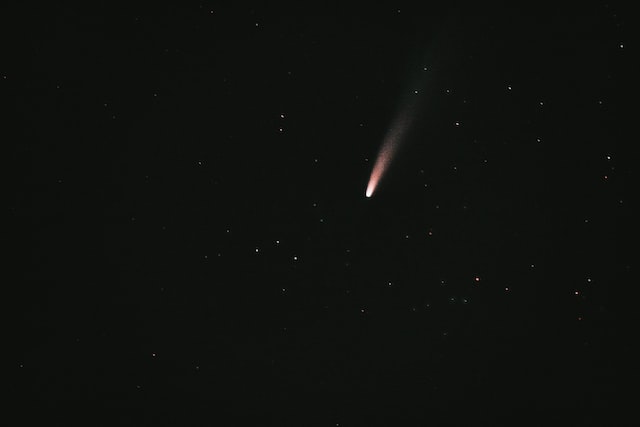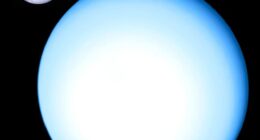Asteroids and comets are two very distinct small bodies in our Solar System. While both of them tend to be made of rock and ice, their origins, orbits and compositions differ greatly. Asteroids commonly orbit close to the Sun while comets often spend most of their journey far from it.
What are asteroids?
(Image by A Owen from Pixabay )

Asteroids are small, rocky objects that orbit the sun. They are usually found in the asteroid belt, a region between Mars and Jupiter where they are thought to have formed. Some asteroids are only a few meters in diameter, while others can be hundreds of kilometres in size. They are considered to be remnants of the early solar system and are thought to be made of rock and metal. Most asteroids are found in the asteroid belt, a region between the orbits of Mars and Jupiter. Asteroids orbit the Sun just like comets but do not have tails.
What are comets?
(Photo by Justin W on Unsplash )

Comets, on the other hand, are composed of a mixture of ice, rock, and dust. They are much larger than asteroids and are known for their bright, glowing tails. When a comet approaches the sun, the heat causes the ice to evaporate, creating a spectacular display. Comets are thought to have formed in the outer reaches of the solar system and are believed to be made of material from the early solar system. Comets are sometimes called “dirty snowballs.”
The difference between asteroids and comets
Asteroids are small, rocky bodies that orbit the sun. Most of them are found in the asteroid belt, a region of space between Mars and Jupiter. Comets are icy, dusty bodies that also orbit the sun. They are usually much smaller than asteroids and have long, elliptical orbits. Occasionally, a comet’s orbit will bring it close to the sun, causing it to “wake up” and release gas and dust. This forms a tail that points away from the sun.
Composition of Asteroids and Comets
The main difference between asteroids and comets is their composition. As mentioned earlier, asteroids are primarily made of rock and metal, while comets are made of ice, rock, and dust. This difference in composition also affects their appearance and behavior. For example, asteroids do not have tails like comets because they do not emit gas or dust as they approach the sun.
Size of an asteroid and a comet?
The size of an asteroid or a comet can vary greatly, with some asteroids being larger than some comets and vice versa.
Asteroids can range in size from a few meters to hundreds of kilometers in diameter. The largest asteroid, Ceres, is about 590 miles (940 km) in diameter, making it the largest object in the asteroid belt.
Comets, on the other hand, can range in size from a few meters to tens of kilometers in diameter. Their size can vary greatly due to the fact that they are made up of ice, dust, and other volatile materials, which can vaporize and release gas and dust as they approach the Sun.
So, it is not possible to make a general statement about which is bigger, an asteroid or a comet, as it depends on the specific object in question.
Orbit of Asteroids and Comets
Another difference between asteroids and comets is their orbits. Asteroids are generally found in the asteroid belt and have stable, circular orbits around the sun. Comets, on the other hand, have highly elliptical orbits that take them far from the sun and then bring them close again. This variation in orbit can cause comets to emit gas and dust, creating their characteristic tails.
Threat to Earth
Despite their differences, both asteroids and comets can pose a threat to Earth. Large asteroids have the potential to collide with our planet and cause significant damage, while comets can also impact the Earth and cause widespread destruction. For this reason, scientists and astronomers study these celestial bodies to better understand their behavior and to track any potential threats.
What is a meteor?
A meteor is a small celestial object that enters the Earth’s atmosphere and burns up due to friction, creating a bright streak of light in the sky, known as a meteor or shooting star. Most meteors are small, ranging from a few millimeters to a few centimeters in size and are composed of rock, metal, or ice.
What is the major difference between asteroid and comet orbits?
Asteroids and comets are two different types of celestial objects with different characteristics, including their orbits.
Asteroids are rocky or metallic objects that primarily orbit the Sun in a belt between Mars and Jupiter. Their orbits are generally more stable and circular, with little deviation from their average position.
Comets, on the other hand, are made up of ice, dust, and other volatile materials. They typically have highly elliptical orbits, which bring them close to the Sun and then far away from it. As a result, the heat from the Sun causes the ice in a comet’s nucleus to vaporize and release gas and dust, creating a bright, glowing coma around the nucleus and a tail that always points away from the Sun.
The major difference between asteroid and comet orbits is that asteroid orbits are more stable and circular, while comet orbits are highly elliptical and bring them close to the Sun.
Can comets hit Earth?
Yes, comets can hit Earth. However, such impacts are relatively rare, and the likelihood of a large comet striking the Earth and causing significant damage is low.
Comets are primarily composed of ice, dust, and other volatile materials, and their orbits can be influenced by the gravitational pull of nearby planets and other celestial bodies. This can cause their orbits to change and bring them into the inner solar system, where they can potentially collide with Earth.
There have been several instances in the past where comets have hit Earth. For example, the Tunguska event in 1908, which flattened an estimated 80 million trees over an area of 830 square miles (2,150 km²) in Russia, is believed to have been caused by the impact of a comet or a stony meteoroid.
Another example is the Shoemaker-Levy 9 comet, which struck Jupiter in 1994. This impact provided scientists with valuable information about the behavior and structure of comets and the effects of their impacts on celestial bodies.
In conclusion, while comets can hit Earth, such impacts are relatively rare and the likelihood of a large comet causing significant damage is low. However, scientists continue to study comets and their potential impact on Earth to better understand and prepare for any potential future impacts.
How many comets have hit Earth?
It is difficult to determine the exact number of comets that have hit Earth because many small comet impacts go unnoticed. However, scientists estimate that a few small comets collide with Earth each year. The number of larger comet impacts, capable of causing significant damage, is much lower and likely to be in the range of a few per million years.
It is worth noting that even small comet impacts can release a large amount of energy and potentially cause significant damage if they occur in a populated area. However, most of Earth’s surface is covered by oceans, which would help to mitigate the effects of a comet impact.
Do asteroids still hit Earth?
Yes, asteroids still hit Earth, although the frequency and likelihood of a significant impact is relatively low.
Asteroids are small, rocky objects that orbit the Sun and can enter Earth’s atmosphere and collide with the planet’s surface. Most asteroids are small and burn up in the atmosphere, causing no harm to the surface. However, larger asteroids can survive their passage through the atmosphere and impact the surface, potentially causing significant damage.
Scientists estimate that a few small asteroids collide with Earth each year, with most of them falling in remote areas such as the ocean or in sparsely populated regions. In recent history, there have been several instances of small asteroids causing significant damage, such as the Chelyabinsk meteor impact in Russia in 2013, which injured over 1,000 people and caused widespread damage.
In conclusion, while the likelihood of a significant asteroid impact is low, such impacts can still occur and have the potential to cause significant damage. Scientists continue to study asteroids and their potential impact on Earth to better understand and prepare for any potential future impacts.
Can we shoot down asteroids?
In theory, it is possible to shoot down an asteroid, but it would require significant technical capability and resources.
The most practical way to shoot down an asteroid would be to use a spacecraft to collide with the asteroid and alter its trajectory. This would require a precise understanding of the asteroid’s orbit, size, and composition, as well as the development of a suitable spacecraft capable of traveling to the asteroid and colliding with it.
There have been several missions to study asteroids, but no mission has yet been specifically designed to deflect or destroy an asteroid. The first step in shooting down an asteroid would be to detect it early and then design and develop a suitable mission to deflect or destroy it.
While it is possible to shoot down an asteroid, it would require significant technical capability and resources, as well as a thorough understanding of the asteroid’s orbit, size, and composition. No mission has yet been specifically designed to deflect or destroy an asteroid, but such missions may be developed in the future if the need arises.
What are some famous comets?
There have been many famous comets throughout history, some of the most well-known include:
- Halley’s Comet – One of the most famous comets, Halley’s Comet appears in our sky once every 76 years. It was last seen from Earth in 1986 and is expected to return in 2061.
- Comet Hyakutake – This comet was discovered in 1996 and passed very close to Earth, making it easily visible to the naked eye. It was one of the brightest comets of the 20th century.
- Comet Hale-Bopp – This comet was discovered in 1995 and was one of the brightest comets of the 20th century. It was visible to the naked eye for several months and passed close to Earth in 1997.
- Comet Shoemaker-Levy 9 – This comet was famous for its collision with Jupiter in 1994. The impact created a series of large, bright scars on the surface of the planet and provided valuable information about the behavior and structure of comets.
- Comet McNaught – This comet was discovered in 2006 and became one of the brightest comets of the past 50 years. It was easily visible from Earth, even in bright daylight.
In conclusion, there have been many famous comets throughout history, each with its own unique characteristics and properties. These comets have provided valuable information about the behavior and structure of comets and have captured the imagination of people throughout the world.
How fast do asteroids travel?
Asteroids typically travel much faster than comets. The average speed of an asteroid is about 17 kilometers per second, while the average speed of a comet is only about 5 kilometers per second. This difference in speed is due to the difference in the way that asteroids and comets are heated by the Sun. Asteroids are heated by the Sun directly, while comets are heated by the Sun indirectly through the gases that make up their tails.
Is comet a star or planet?
Comets are not stars, they are small celestial bodies that orbit the sun. Like asteroids, they are left over from the formation of the solar system and are made of rock and dust. However, comets also have a “dirty” or “gaseous” coma around them, which is formed when the comet’s ice melts in sunlight. This coma can make a comet appear very bright in the night sky.
Why do comets glow green?
Comets are small, icy bodies that orbit the Sun. They are made up of dust and ice and often have a tail of gas and dust that points away from the Sun. When a comet gets close to the Sun, the ice melts and the gas turns into a vapor. The vapor then turns into a cloud of dust and gas around the comet nucleus. This cloud is called a coma.
The comet reflects sunlight, which makes it look like the comet is glowing green.
Why do comets burn up?
Comets are often called “dirty snowballs” because they are made up of a mix of ice and dust. They orbit the Sun in long, elliptical paths and as they get closer to the Sun, the ice begins to vaporize. This causes the comet to form a tail of gas and dust that points away from the Sun. Eventually, all of the ice on the comet will be gone and it will become an inactive asteroid.
Featured Image By – Photo by Matt Wang on Unsplash








